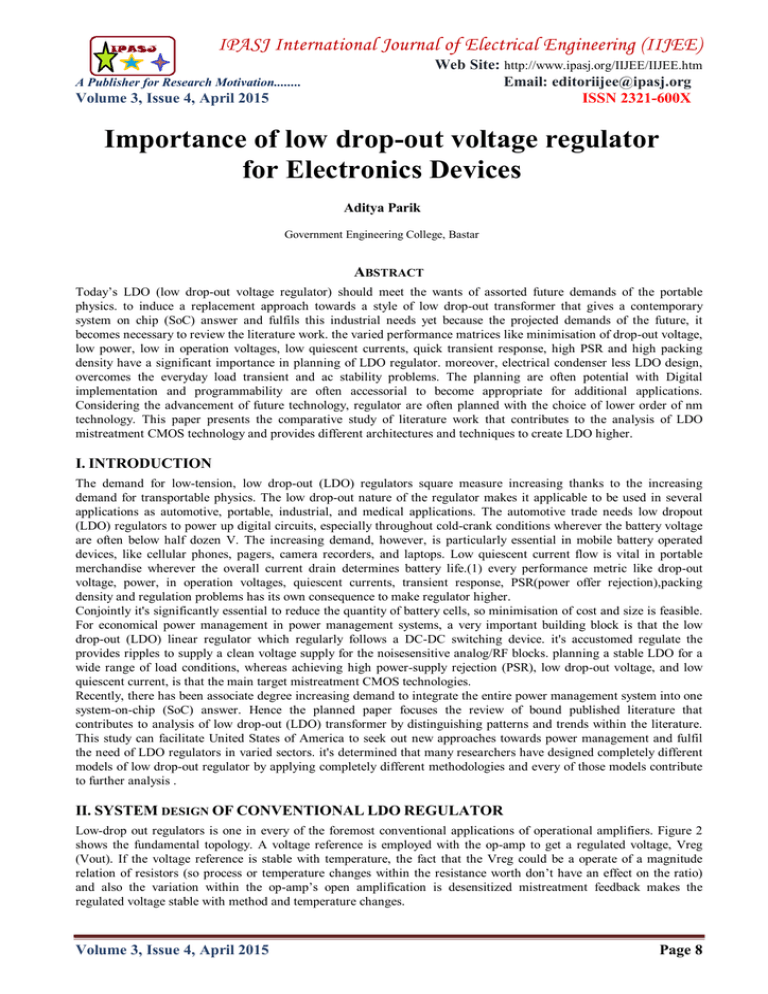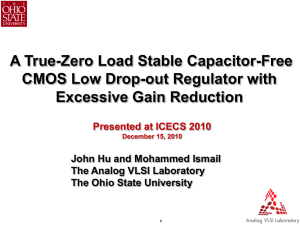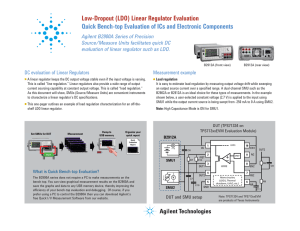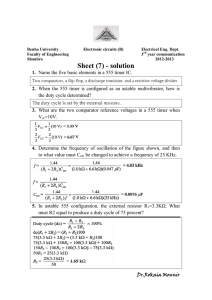Importance of low drop-out voltage regulator for Electronics Devices
advertisement

IPASJ International Journal of Electrical Engineering (IIJEE) Web Site: http://www.ipasj.org/IIJEE/IIJEE.htm Email: editoriijee@ipasj.org ISSN 2321-600X A Publisher for Research Motivation........ Volume 3, Issue 4, April 2015 Importance of low drop-out voltage regulator for Electronics Devices Aditya Parik Government Engineering College, Bastar ABSTRACT Today’s LDO (low drop-out voltage regulator) should meet the wants of assorted future demands of the portable physics. to induce a replacement approach towards a style of low drop-out transformer that gives a contemporary system on chip (SoC) answer and fulfils this industrial needs yet because the projected demands of the future, it becomes necessary to review the literature work. the varied performance matrices like minimisation of drop-out voltage, low power, low in operation voltages, low quiescent currents, quick transient response, high PSR and high packing density have a significant importance in planning of LDO regulator. moreover, electrical condenser less LDO design, overcomes the everyday load transient and ac stability problems. The planning are often potential with Digital implementation and programmability are often accessorial to become appropriate for additional applications. Considering the advancement of future technology, regulator are often planned with the choice of lower order of nm technology. This paper presents the comparative study of literature work that contributes to the analysis of LDO mistreatment CMOS technology and provides different architectures and techniques to create LDO higher. I. INTRODUCTION The demand for low-tension, low drop-out (LDO) regulators square measure increasing thanks to the increasing demand for transportable physics. The low drop-out nature of the regulator makes it applicable to be used in several applications as automotive, portable, industrial, and medical applications. The automotive trade needs low dropout (LDO) regulators to power up digital circuits, especially throughout cold-crank conditions wherever the battery voltage are often below half dozen V. The increasing demand, however, is particularly essential in mobile battery operated devices, like cellular phones, pagers, camera recorders, and laptops. Low quiescent current flow is vital in portable merchandise wherever the overall current drain determines battery life.(1) every performance metric like drop-out voltage, power, in operation voltages, quiescent currents, transient response, PSR(power offer rejection),packing density and regulation problems has its own consequence to make regulator higher. Conjointly it's significantly essential to reduce the quantity of battery cells, so minimisation of cost and size is feasible. For economical power management in power management systems, a very important building block is that the low drop-out (LDO) linear regulator which regularly follows a DC-DC switching device. it's accustomed regulate the provides ripples to supply a clean voltage supply for the noisesensitive analog/RF blocks. planning a stable LDO for a wide range of load conditions, whereas achieving high power-supply rejection (PSR), low drop-out voltage, and low quiescent current, is that the main target mistreatment CMOS technologies. Recently, there has been associate degree increasing demand to integrate the entire power management system into one system-on-chip (SoC) answer. Hence the planned paper focuses the review of bound published literature that contributes to analysis of low drop-out (LDO) transformer by distinguishing patterns and trends within the literature. This study can facilitate United States of America to seek out new approaches towards power management and fulfil the need of LDO regulators in varied sectors. it's determined that many researchers have designed completely different models of low drop-out regulator by applying completely different methodologies and every of those models contribute to further analysis . II. SYSTEM DESIGN OF CONVENTIONAL LDO REGULATOR Low-drop out regulators is one in every of the foremost conventional applications of operational amplifiers. Figure 2 shows the fundamental topology. A voltage reference is employed with the op-amp to get a regulated voltage, Vreg (Vout). If the voltage reference is stable with temperature, the fact that the Vreg could be a operate of a magnitude relation of resistors (so process or temperature changes within the resistance worth don’t have an effect on the ratio) and also the variation within the op-amp’s open amplification is desensitized mistreatment feedback makes the regulated voltage stable with method and temperature changes. Volume 3, Issue 4, April 2015 Page 8 IPASJ International Journal of Electrical Engineering (IIJEE) A Publisher for Research Motivation........ Volume 3, Issue 4, April 2015 Web Site: http://www.ipasj.org/IIJEE/IIJEE.htm Email: editoriijee@ipasj.org ISSN 2321-600X III. KEY PARAMETERS OF LDO REGULATOR Some of the key parameter of low drop-out regulator is discussed where- Ii, Vi–Input current and input voltage Io, Vo – Output current and output voltage A. Dropout Voltage Dropout voltage is that the input-to-output differential voltage at that the circuit ceases to manage against further reductions in input voltage; this time happens once the input voltage approaches the output voltage. B. Quiescent Current or Ground Current Quiescent current, or ground current, is that the distinction between input and output currents. Minimum quiescent current is critical for optimum current potency. IV. COMPLETELY DIFFERENT CIRCUIT TOPOLOGIES ACCUSTOMED STYLE LDO’S. In the year 1998,Gabriel A. Rincon-Mora, Phillip E. Allen in their paper named “ A low-tension, Low Quiescent Current, Low Drop-Out Regulator’’ mentioned some techniques that change the sensible realizations of low quiescent current LDO’s at low voltages and in existing technologies. The planned circuit exploits the frequency response dependence on load-current to minimize quiescent current flow. Moreover, the output current capabilities of MOS power transistors square measure enhanced and drop-out voltages square measure diminished for a given device size. A drop-out voltage conjointly have to be compelled to be reduced to maximize dynamic vary at intervals a given power offer voltage. During this paper, 2 important contributions specifically current economical buffer and current boosted pass device, make the low-tension style viable for battery battery-powered circuits. each these techniques cash in of the availability of a way component that gives a linearly load dependent current. this is often intrinsic for low quiescent current flow throughout low load-current conditions. The resulting circuit takes most advantage of the transistors utilised to yield low part count and low overall ground current. moreover, this boosting technique are often promptly enforced in applications requiring low switch-on resistors, i.e., dc-dc converters. In the year 2007, Robert J. Milliken, Jose Silva- Martínez, and King of Great Britain Sánchez-Sinencio, in their paper named, “Full on-chip CMOS low-dropout voltage regulator” planned an answer to this large external electrical condenser low-dropout (LDO) voltage regulators with associate degree external electrical condenser less LDO design. The large external electrical condenser utilized in typical LDOs is removed allowing for bigger grid integration for systemon- chip (SoC) applications. The compensation theme is presented that gives each a quick transient response and full vary electrical energy (ac) stability from zero to 50- mA load current although the output load is as high as a hundred pF. This paper poses to get rid of the massive external capacitor, whereas guaranteeing stability underneath all in operation conditions mistreatment zero.35μm CMOS technology. Removing the large off-chip output electrical condenser conjointly reduces the board real estate and also the overall price of the look and makes it suitable for SoC styles. There square measure the subsequent 2 major style concerns 1) tiny over/under shoots during transients and 2) the regulator’s stability. To solve these problems, a compensating left-hand plane (LHP) zero is introduced within the planned style. Not solely will the proposed regulator consume low power, however it provides a low dropout voltage and quick subsidence time. SoC styles would enjoy the reduced board property, pin count, and price accomplishable with the planned off-chip capacitor less full CMOS LDO regulator. In March 2010, Mohamed El-Nozahi, Ahmed Amer, Joselyn Torres, Kamran Entesari and King of Great Britain Sánchez- Sinencio, in their paper named “ High PSR Low Drop- Out Regulator With Feed-Forward Ripple Cancellation Technique’’ bestowed a coffee drop-out (LDO) regulator with a feed-forward ripple cancellation (FFRC) technique that achieves a high power-supply rejection (PSR) over a wide frequency vary. Kelvin association is additionally accustomed increase the gain–bandwidth of the LDO that permits for faster transient performance. The LDO was enforced in 0.13μm CMOS technology and achieves a PSR higher than 56 dB. this is often the primary LDO that achieves such a high PSR up to ten MHz additionally; it allows the look for high offer currents and low quiescent current consumption. The planned topology provided a strong design once the method, temperature and bonding inductance variations square measure thought-about. The FFRC are often extended to any existing LDO design to yield a high PSR for a good vary of frequencies. additionally, it was shown that Kelvin association at the output helps to increase the GBW of the LDO while not poignant the stability at significant hundreds. In year 2010,Amit P. Patel and archangel A. Rincon- Mora in their paper, “High Power-Supply-Rejection (PSR) Current-Mode Low-Dropout (LDO) Regulator,” bestowed a 5-mA 1.5-μm bipolar current-mode LDO regulator that, with the next information measure current loop, suppresses higher frequency noise by forty nine sound unit (i.e., power offer rejection) up to ten MHz with solely sixty eight nF at the output, that is twenty sound unit better than its voltagemode counterpart. trendy systemon- a-chip (SoC) solutions suffer from restricted on-chip capacitance, which suggests that the switch events of functionally dense ICs induce goodish noise within the supplies. This ripple worsens the accuracy of sensitive analog physics. while not dropping a considerable voltage, point-of-load (PoL) low-dropout (LDO) regulators scale back (filter) this noise however solely the maximum amount as their loop gains and bandwidths permit. Volume 3, Issue 4, April 2015 Page 9 IPASJ International Journal of Electrical Engineering (IIJEE) A Publisher for Research Motivation........ Volume 3, Issue 4, April 2015 Web Site: http://www.ipasj.org/IIJEE/IIJEE.htm Email: editoriijee@ipasj.org ISSN 2321-600X The prototyped one.5-μm bipolar LDO achieved this performance by increasing the ohmic resistance to the supply with a current-sampling electric circuit. The loop basically samples the output current with a mirroring sense electronic transistor and mixes it into the most (voltage) loop through a frequency shaping (RCdegenerated) differential try. any suppressing the supply ripple (by 6×) during this method prevents switch converter noise from rendering sensitive analog functions ineffectual. Many techniques are planned for planning LDO regulators with a programmable output voltage [9]- [11]. In Jan 2012,Jia-Hui Wang, Chien-Hung Tsai and Sheng-Wen Lai in their paper, “A Low-Dropout regulator with tail current management for DPWM clock correction’’ presented a low-dropout (LDO) regulator with tail current control (TCC) that consists of a twin differential try, a 5- bit current data converter, and a current summation circuit mistreatment zero.18μm CMOS technology. The TCC adjusts the tail current magnitude relation of the twin differential pair of the LDO regulator to realize a programmable output voltage mistreatment 5-bit digital signals. The power supply rejection over a good frequency vary is improved with addition of supply-ripple isolation mechanism. The proposed LDO regulator with TCC provides a offer voltage to a DPWM (digital pulse dimension modulation) to achieve a 32-level generator frequency. The DPWM could be a voltage-controlled generator (VCO), and low-dropout (LDO) regulators that square measure used for the provision voltage of VCOs as a result of they need advantage of reduced offer noise, permitting a gradual generator frequency in a very SoC chip. additionally, the PSR performance improved by concerning 20 sound unit over a good frequency vary as a result of associate degree isolation mechanism. Therefore, the planned LDO regulator is suitable for correcting the generator frequency of DPWMs. On the opposite hand, the TCC technology wants accurately to adjust tail current to realize the 32-level output voltage of the LDO regulator; so, the transistors size of the TCC circuit is therefore giant that the planned LDO occupies more space than previous LDO regulators. This brief proposes associate degree LDO regulator with a programmable output voltage, that adjusts the clock of a DPWM and provides it with a clean offer voltage. In the year 2013, Yen-Chia Chu and Le-Ren Chang- Chien introduced a digitally controlled low-dropout voltage regulator (LDO) in their paper entitled, “ Digitally Controlled Low-Dropout Regulator with Fast-Transient and motor vehicle standardisation Algorithms’’ which will perform fasttransient and motor vehicle tuned voltage. As there square measure still many arguments relating to the digital implementation on the LDOs, benefits and downsides of the digital management are 1st mentioned during this paper as an example its chance in the LDO applications. This paper brings new construct to digitize LDO’s mistreatment zero.18μm CMOS technology. Following that, the design and configuration of the digital theme square measure incontestable . underneath the new style concept, many drawbacks of the digital implementation would be minor. This paper presents a D-LDO with various options that failed to seem within the counterpart of the analog one. completely different from the analog approach, a digital compensation theme is incontestable to unravel the ESR zero drawback once alittle output electrical condenser is employed. It’s noted that the planned digital theme allows additional styles of compensation to be enforced in the design flow. In addition, to make sure the transient performance, many in operation uncertainties ought to be taken care of by associate degree autonomous manner. Therefore, two auto standardisation strategies to handle the uncertainty drawback were mentioned. the primary motor vehicle standardisation methodology is to regulate the charge-balance current by dominant the driving voltage of the ability MOSFET throughout the transient time. The second motor vehicle standardisation operate is to mechanically assign proper initial values for the compensator for avoiding ringing at output voltage. conjointly the D-LDO is strong once it is in operation underneath the conditions of low offer voltage and wide offer voltage variation. one in every of the drawbacks in the digital management is that the power consumption issue as power consumption of the digital controller is more than that of the analog controller. In 2014, Chung-Hsun Huang, Ying-Ting Ma and Wei- Chen dynasty in their paper entitled “Design of a Low- Voltage LowDropout Regulator,” bestowed a low-tension low-dropout (LDO) regulator that converts associate degree input of one V to associate degree output of zero.85–0.5 V, with 90-nm CMOS technology. A straightforward isobilateral operational transconductance amplifier is employed because the error electronic equipment (EA), with a current cacophonous technique was adopted to spice up the gain. This conjointly enhances the closed-loop information measure of the LDO regulator. within the rail-to-rail output stage of the Semitic deity, a power noise cancellation mechanism is made, minimizing the dimensions of the ability MOS electronic transistor. Furthermore, a quick responding transient accelerator is designed through the reprocess of elements of the Semitic deity. These advantages permit the planned LDO regulator to control over a good vary of in operation conditions whereas achieving 99.94% current potency, a 28-mV output variation for a 0–100 mA load transient, and an influence offer rejection of roughly fifty sound unit over 0–100 kc. This paper planned associate degree LDO regulator employing a straightforward OTA-type Semitic deity and associate degree adaptive transient accelerator, which may succeed operation below 1 V, quick transient response, low IQ, and high PSR under a good vary of in operation conditions. Volume 3, Issue 4, April 2015 Page 10 IPASJ International Journal of Electrical Engineering (IIJEE) A Publisher for Research Motivation........ Volume 3, Issue 4, April 2015 Web Site: http://www.ipasj.org/IIJEE/IIJEE.htm Email: editoriijee@ipasj.org ISSN 2321-600X V. RESULT AND DISCUSSION From review of printed literature, it's determined that many researchers have designed completely different models of low drop-out regulator by applying completely different methodologies. Also several phenomena are undertaken to boost the transient response of the LDO regulators and to combat with stability problems and power management problems. potency obtained with mentioned planned LDO architectures is concerning ninety eight.The LDO architectures in [1] and [5] offer current potency of ninety nine.94% and 99.95% severally whereas [4] &[5] provides PSR of concerning 57dB at 100KHz.It is seen that nm technology proves better in achieving needed performance specifications. The large external electrical condenser utilized in typical LDOs will be removed permitting bigger grid integration for system-on-chip (SoC) applications that need a sound compensation theme for each the transient response and the electrical energy (ac) stability. Presently, in some applications, the external electrical condenser used is kind of giant (10 μF), however electrical condenser less architectures [4] are proposed and kind a big a part of current CMOS LDO style literature. The planned circuit are going to be ready to exploit the frequency response dependence on load-current to minimize quiescent current flow so current economical buffer and current boosted pass device are often created the low-voltage style viable for battery battery-powered circuits. The advanced power management unit (PMU) construct inside the SoC theme conjures up the digital management potential for the look of a completely unique D-LDO regulator that's capable to perform quick transient and performing arts the DVS operate can be accustomed propose LDO with digital implementation responsible to extend space of applications [2]. An error amplifier structure to boost load regulation of lowvoltage, low-dropout regulators are often utilized. The TCC adjusts the tail current magnitude relation of the twin differential pair of the LDO regulator to realize a programmable output voltage mistreatment 5-bit digital signals. In [9]–[11], external management signals open or short the switch transistors to vary the feedback electrical device divider ratio to realize a programmable output voltage. However, extra resistors and switch transistors square measure required for additional output voltages. The FFRC technique are often extended to any existing LDO design to yield a high PSR for a good vary of frequencies [4]. A LDO regulator using a straightforward OTA-type Semitic deity and associate degree reconciling transient accelerator succeed quick transient response, low IQ, and high PSR underneath a good vary of in operation conditions. If in the rail-to-rail output stage of the Semitic deity, an influence noise cancellation mechanism is made, the dimensions of the ability MOS electronic transistor are often reduced [1]. VI. CONCLUSION By examination circuit topologies for planning LDO regulator, it's seen that normally, all LDO specifications constrain one another. it's troublesome to boost all of them simultaneously. because the varied performance matrices such as minimisation of drop-out voltage, low power, low operating voltages, low quiescent currents, quick transient response, high PSR and high packing density have a significant importance in planning of LDO regulator, future LDO should watch out for of these matrices. The electrical condenser less LDO design sounds smart in overcoming the everyday load transient and ac stability problems. moreover, the designing are often potential with digital implementation and programmability are often accessorial to become appropriate for more applications. conjointly future nm technology offers additional advantages in achieving most of the performance specifications therefore considering the advancement of future technology, regulator are often planned with the choice of lower order of nm technology to fulfil targeted demands. REFERENCES [1]. Chung-Hsun Huang,Ying-Ting Ma, and Wei-Chen Liao, “Design of a Low-Voltage Low-Dropout Regulator,” IEEE Transactions on Very Large scale Integration (VLSI) systems, vol. 22, no. 6, pp.1308-1313,June 2014. [2]. Yen-Chia Chu and Le-Ren Chang-Chien, “Digitally Controlled Low-Dropout Regulator with Fast-Transient and Autotuning Algorithms’’ IEEE Transactions on Power Electronics, vol. 28, no. 9,pp.4308-17, September 2013. [3]. Jia-Hui Wang, Chien-Hung Tsai,and Sheng-Wen Lai, “A Low- Dropout Regulator With Tail Current Control for DPWM Clock Correction’’, IEEE Transactions on Circuits and Systems—ii: express briefs, vol. 59, no.1,pp,45-49 January 2012. [4]. M. El-Nozahi, A. Amer, J. Torres, K. Entesari, and E. Sanchez- Sinencio, “High PSR low drop-out regulator with feed-forward ripple cancellation technique,” IEEE J. Solid-State Circuits, vol. 45, no. 3, pp. 565–77, Mar. 2010. [5]. A. P. Patel and G. A. Rincon-Mora, “High Power-Supply-Rejection (PSR) Current-Mode Low Dropout (LDO) Regulator,” IEEE Trans.Circuits Syst. II, Exp. Briefs, vol. 57, no. 11, pp. 868–73, Nov. 2010. Volume 3, Issue 4, April 2015 Page 11 IPASJ International Journal of Electrical Engineering (IIJEE) A Publisher for Research Motivation........ Volume 3, Issue 4, April 2015 Web Site: http://www.ipasj.org/IIJEE/IIJEE.htm Email: editoriijee@ipasj.org ISSN 2321-600X [6]. Ka Nang Leung, Yuan Yen Mai, and Philip K. T. Mok “ A Chip- Area Efficient Voltage Regulator for VLSI Systems’’, IEEE Transactions on Very Large Scale Integration (VLSI) systems, vol.18, no. 12,pp.1757-62, December 2010. [7]. R. J. Milliken, J. Silva-Martinez, and E. Sanchez-Sinencio, “Full on-chip CMOS Low-Dropout Voltage Regulator,”IEEE Trans. Circuits Syst. I, Reg. Papers, vol. 54, no. 9, pp. 1879–90, Sep. 2007. [8]. Gabriel A. Rincon-Mora, and Phillip E. Allen, Fellow, “A Low- Voltage, Low Quiescent Current, Low Drop-Out Regulator” IEEE Journal of Solid-state Circuits, vol. 33, no.1, pp.36-44, January 1998. [9]. Y. C. Wu, C. Y. Huang, and B. D. Liu, “A Low Dropout Regulator with Programmable Output,” in Proc. IEEE Conf. Ind. Electron. Appl., pp. 3357–3361, June 2009. [10]. J. M. Shen, W. B. Yang, C. Y. Huieh, and Y. L. Lo, “A Low Power Multi-Voltage Control Technique with FastSettling Mechanism for Low Dropout Regulator,” in Proc. IEEE Int. Symp. Integr. Circuits, pp. 558–61, Feb.2009. [11]. C. Y. Tseng, L. W. Wang, and P. C. Huang,“An integrated linear regulator with fast output voltage transition for dual-supply SRAMs in DVF system,” IEEE J. Solid-State Circuits, vol. 45, no. 11, pp. 2239–2249,Nov. 2010. Volume 3, Issue 4, April 2015 Page 12


